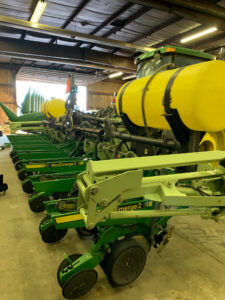As temperatures slowly start to rise, the time has come for all Midwestern crop farmers to return from their extended vacations and get back to work. If only that were the case! Rather, farmers have been working all winter because America’s food production system doesn’t stop when there aren’t crops in the ground. So, what do row crop farmers do during the winter months? While warmer climates sound amazing during our long winters, there is plenty to do around the farm after harvest!
Winter is a perfect time to take care of any equipment maintenance. Many farmers, including my husband Seth and I, take the winter downtime as an opportunity to service equipment and get things ready to roll for spring planting. That way, once warm weather comes our way and soil temperatures begin to rise, we’re ready to get back into the fields. Farmers want to ensure that crops have plenty of time to grow and flourish during the warm months. In addition to preparing the planter, farmers also take time to fix and clean all harvest equipment to ensure functionality and to prevent the transfer of weeds and/or other materials. Farmers will also change the oil in all of the tractors (tractors need oil changes just like cars!) to make sure they operate efficiently.

Winter is also meeting season. Many organizations like Nebraska Extension, seed companies, and equipment dealerships use this downtime to host meetings across the state or meet individually with farmers. Farmers attend these meetings to ensure they are up-to-date on agricultural production practices and technologies. Farmers want to grow crops in environmentally responsible ways while producing high yields. These meetings, seminars, and workshops act as continuing education courses for farmers, who continually strive to improve their agricultural production practices.

Just a few weeks ago, my husband Seth and I met with our local seed dealers. We discussed different seed varieties, what fields each variety would be best suited for and when the seed will be delivered. Farmers like ourselves work with their seed dealers each season to make a detailed plan for their farm. Across a farm, fields may have different needs and the seed choice needs to reflect that. Farmers want to make sure they are making the best choice not only for themselves but also for the soil and land they are tasked with taking care of!

As I mentioned earlier, farmers will service their machinery to ensure everything is functioning properly. If needed, farmers may meet with their local equipment dealer to go over their needs for the upcoming season. Like in all forms of transportation, technology is always evolving, and the same holds true for agricultural machinery. There are always cool new gadgets for farmers to try and implement on their farms. While it is very expensive to purchase new equipment, upgrading different parts of a planter or upgrading the technology in a tractor can be a less expensive way to improve equipment. As technology improves, tractors, planters, and combines can become more efficient and use less energy. For example, a recent technological advancement many farmers now use is called auto steer. This technology allows for more precise planting and harvesting, as farmers use GPS to decrease gaps and overlaps in the field, which results in less soil compaction because farmers are making fewer trips through the fields. This precision technology also allows farmers to apply fertilizers more accurately.
With the rapid pace of changing technology and innovation, winter meetings are also a good chance for farmers to learn. Not only from experts in different fields but also from each other. The University of Nebraska-Lincoln offers many research-focused events through its extension service. Nebraska Extension programs are focused on science, but they also include a component where farmers are able to learn from each other. When you get a bunch of farmers in a room, no matter where they are, they will inevitably talk about how they do things “on their farm.” These conversations can spark new ideas that other farmers can take back and incorporate on their own farms. A few weeks ago, I attended the Nebraska Women in Agriculture Conference in Kearney. This two-day event is put on by Nebraska Extension exclusively for women involved in the agricultural industry. No matter what you grow or raise on your farm, there is something for you to learn! This year’s topics included taxes, family communication, knowing your soil, transition planning, and more.

Farmers also take time during the early spring months to prepare their fields for the upcoming growing season. They’ll look for and remove any possible debris and move cattle that have been grazing on last season’s cornstalks. If a farmer has a hilly field, they also will be out during early spring examining and possibly repairing terraces to prevent soil erosion and potential soil runoff during heavy spring and summer rains.

With all of these activities taking place, farmers are starting to get “the itch” to get their planters back into the fields. Farming is something that’s in our blood, and we feel passionate about growing and producing quality food, fuel, and fiber. While the growing season is undoubtedly our favorite time of the year, much still needs to be completed during the winter months!

